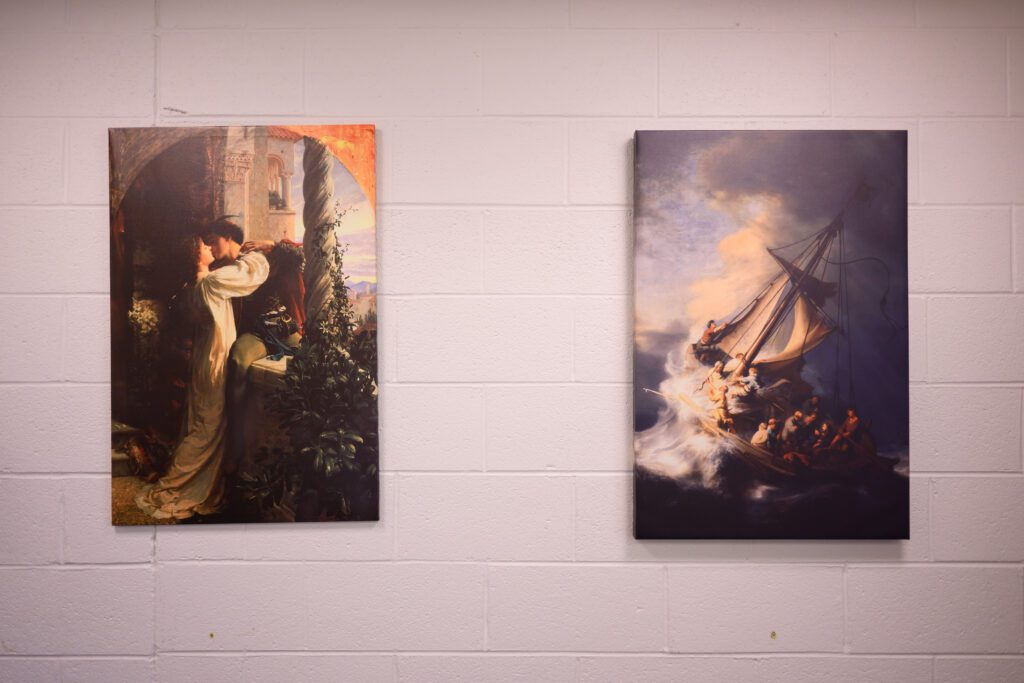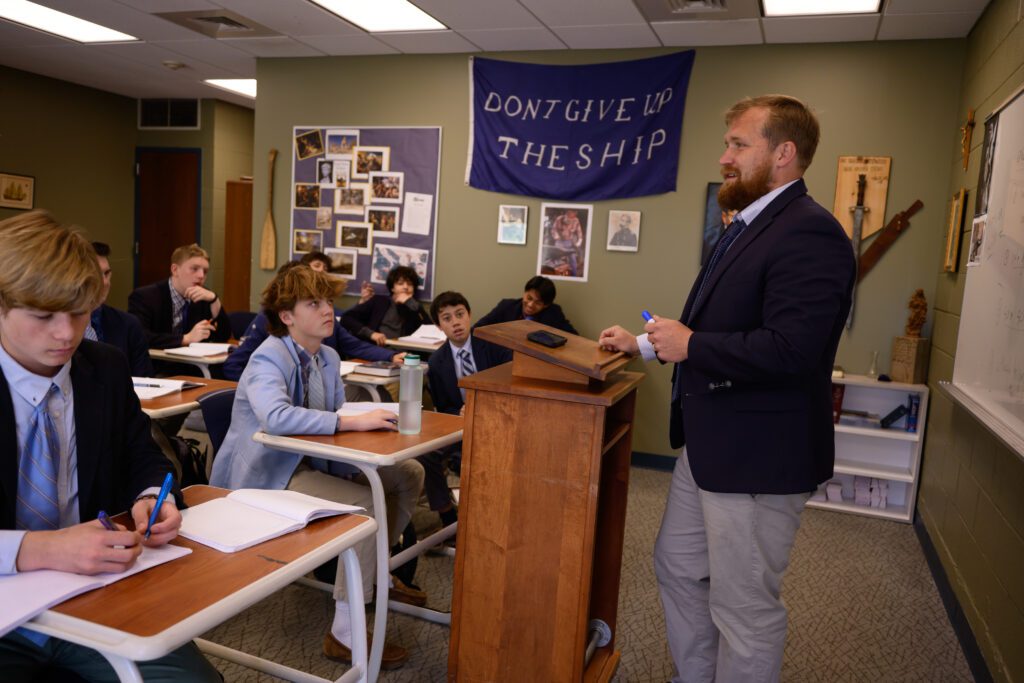In conversation with a group of eighth graders one day, I observed, unsurprisingly, a consensus distaste for institutional education. One honest interlocutor opined that “school is like a prison.” Before I could fire up the indignation furnace or retreat into an intellectual hermitage, several of the forthright fellow’s classmates, in a display of camaraderie, pounded on the walls with their fists. This had the unexpected effect of directing my attention toward the wall. As I looked, I experienced distaste, myself. The walls were large concrete blocks, glaring back at the harsh fluorescents staring out of the ceiling. The room was plotted out into neat little cells: one square for each square desk, a bigger square for the teacher’s ponderous desk, and square windows built squarely into the heavy block walls. No barred doors, true, but the desks were small restrained spaces out of which students are not supposed to move.
Ultimately, I disagree with their sentiment, but I could certainly see what they were talking about. Moreover, I could see that these were things out of their control. For them to banish the prison imagery would be a constant fight against the suggestions of their surroundings.
Two thoughts occur to me. First, why is this kind of discouraging environment standard in educational institutions? Second, what, if anything, can we do to improve it?
This kind of environment exists for three main reasons: economy, efficiency and guardianship.
Economy
Any kind of large scale construction project must maintain a responsible budget. Luxury costs are often prohibitive, and it is better to have the building than to abandon the project because wood paneling is too costly.
Efficiency
Anything that involves regular movement of large groups of people needs a clear and recognizable organization. The classroom arrangements need to be neat and obvious. Worth close evaluation is the extent to which pursuit of economy and efficiency stem from an Industrial mindset. This mindset, favoring function over person, classifies students as products who must be grouped according to age and processed along a conveyor belt of identical courses, regardless of ability, affinity, maturity, or vocation. The Industrial mindset disregards individual institutions as well as persons, and only some kind of major social shift could revise the system. Apart from the unfortunate side effects perpetrated by industrialization, though, economy and efficiency are virtues and to be applied well and prudently. What practical shape that takes remains to be seen.
Guardianship
What is aesthetically pleasing is also more easily damaged. Marker graffiti is easier to remove from painted concrete blocks than carved graffiti from wood. Based on reliable experience, we consider the young to have a conscious or unconscious instinct for destruction. That rug will not stay unstained for long, and the lamp will certainly (of its own accord, naturally) jump off the end table and shatter on the floor. The other unfortunate human instinct, and the reason for the seventh commandment, is the instinct to steal. For these reasons, we become protective of good things, so we attempt to contain all threatening forces, thereby limiting the damage. The simplest way to limit the damage is to avoid having the damageable things. But Occam’s razor doesn’t necessarily cut it, and the simplest solution is not always the right one.
I suspect the art of sturdy (and aesthetically pleasing) construction, conducted outdoors, would be a profitable learning experience for most. By way of example, the sixth grade Craftsmanship class here at The Heights are designing and creating chairs and ladders. The middle school occasionally has a contest for building small bridges, some of dubious stability. But opportunities like this are few and far between, and unfortunately not practical for the modern demanding high school education system.
Solutions and Next Steps
So what is the solution to all these theoretical, moral, and practical challenges? Enlivening the classroom through ambience rather than activity.

Here’s what I did. I hung complementary 24” x 32” canvas prints of Rembrandt’s Sea of Galilee and Dicksee’s Romeo and Juliet. I put in a bookshelf with all manner of reading material, mostly not curricular. A tiny icon of Mother Mary, a stone armadillo, an odd steampunk table clock, two odd thrift store cups (I used them for extra pencils), and a small pot of succulents fill out corners. A glowing planet lamp (bulb broken, but the globe remains) resides on another small shelf. A large squashy armchair with a mismatched ottoman now serves as “The Throne,” the reigning king being whoever has made a particularly enlightening comment. Behind the throne are a lamp and a tall artificial plant. Next to it on a small table is another set of books, bookended by some contemplative monks (we’re reading A Canticle for Leibowitz). Some fantasy world maps hang aloft, and five lamps do their best, with the help of the unblinded windows, to provide our light. I couldn’t do anything about the blocky gray tables, but I placed them in an unconventional arrangement more conducive to conversation.

Next on the list (though this might cross over into wishful thinking): curtains or blinds that aren’t colorless plastic strips, and a real overhead light. Begone, fluorescent excrescence! We have an outlet in the ceiling, so I’m going to call it being halfway there. Distant hope, almost certainly outside the range of practicality, real and interesting tables and chairs, preferably of different sizes, shapes, colors, and materials, acquired one at a time. One can dream. But man, oh man, they would love it. They would look forward to every class there.
Wall art is the most obvious thing to add, but dentist office blanditude will not suffice. Meaningful images that inspire delight and thought are necessary. Objects small and large, placed on any available surface such as a bookshelf or a windowsill, makes the experience three-dimensional. The root meaning of the word “ambience” is “going around”: art and objects of interest should surround the students, not just adorn one wall or one shelf. Objects should be both small and large; some to immediately draw the eye and some more hidden, to be discovered. Plants make people happier: have some plants. Even artificial ones are a good start. Don’t make everything squares, have some irregular or rounded edges on shapes, furniture, desk arrangements. And the biggest thing, and the most challenging: have real lighting. Fluorescents are cheap and efficient, but even their unobservable flickering is oppressive, and their cold soullessness reduces us to functioning or non-functioning objects. This, like enforcing primacy of efficiency, is dehumanizing. Desk and floor lamps immediately make the room a place students want to be, because it is not clinical, it is welcoming. Warm lighting tacitly recognizes us as flesh-and-soul people, deserving of love and respect.
Setting up a classroom this way entails, perhaps more than anything else, trust. Trust is difficult because of the human inclination to kill (or in this case, damage) and to steal. In our case, the bulb of the glowing planet spontaneously burst, and the two pencil cups have deviated willfully from their repose. The reason for hope, though, is that students, tired of what they term “prison”, value this ambience themselves. They see this kind of classroom as a place they want to keep, and want no one else to spoil. The lower level of respect solicited by low features goes up in proportion to the admirability of the ambience. They are inclined to become guardians themselves.
Human beings connect the ambience of a place to the activity within it. Students connect an enjoyable atmosphere to the content of the class. They look forward to it, and sometimes make explicit connections. We now have a wall painting of Romeo and Juliet embracing, and while we were reading Hamlet, the class joked about how it was really a picture of Hamlet and Gertrude. They won’t easily forget about the oedipal interpretation of that relationship, which means they won’t forget either the painting or the play. Another side effect I’ve noticed is a greater sense of discretion and dignity in movement and posture. Students are still inclined to get up out of their seat to get an extra pencil, but now gentlemen move smoothly and quietly around the periphery, rather than swaggerers plowing brashly through and upending the intellectual conversation. I’m wondering how long this will last, but it’s been a pattern for two months now.
Other Faculty Perspectives
I asked other faculty why classroom ambience is important. Here are some of their thoughts.

- Mr. Anton Vorozhko: A well-crafted classroom ambience “awakens curiosity and gives a feeling of being invited in”.
- Mr. Michael Ortiz: It gives us a sense of “being in someone’s home again” (I love the addition of the word “again”).
- Mr. Chris Breslin: It maintains for us “a connection to the tactile”, which is something rapidly shrinking in proportion to the expanding cyberspace.
All of these teachers agreed that this kind of classroom ambience makes their learning experience “personal”. You are sharing yourself with them, not just the material. Perhaps giving them that respect and trust is what elevates them the most, encouraging them to respect themselves each day more than the day before, and to see the world with new love and wonder.

